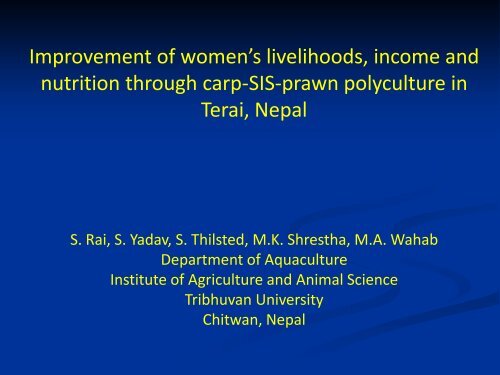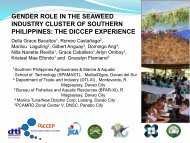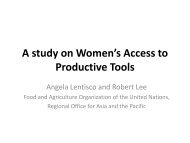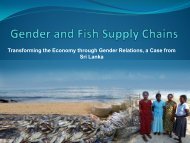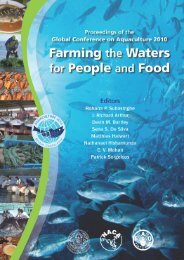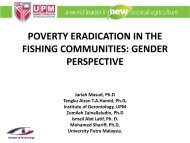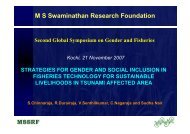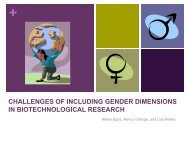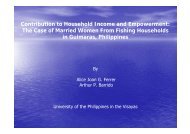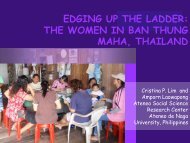Sunila Rai - GENDER IN AQUACULTURE AND FISHERIES
Sunila Rai - GENDER IN AQUACULTURE AND FISHERIES
Sunila Rai - GENDER IN AQUACULTURE AND FISHERIES
Create successful ePaper yourself
Turn your PDF publications into a flip-book with our unique Google optimized e-Paper software.
Improvement of women’s livelihoods, income and<br />
nutrition through carp-SIS-prawn polyculture in<br />
Terai, Nepal<br />
S. <strong>Rai</strong>, S. Yadav, S. Thilsted, M.K. Shrestha, M.A. Wahab<br />
Department of Aquaculture<br />
Institute of Agriculture and Animal Science<br />
Tribhuvan University<br />
Chitwan, Nepal
Partner Institutions<br />
1. Institute of Agriculture and Animal Science<br />
2. Rural Integrated Development Society<br />
3. Fisheries Development Centre<br />
4. Resource Empowerment Society<br />
Supporting Technical Partner Institutions<br />
1. Bangladesh Agricultural University, Bangladesh<br />
2. University of Copenhagen, Denmark
Introduction<br />
• Malnutrition caused by vitamin and mineral deficiencies among<br />
poor women and children is a serious health problem in Nepal<br />
(MOHP, 2006).<br />
• Nearly, 48% of children under five years age are anemic and 49%<br />
are stunted (MOHP, 2006). Similarly, 36% of women age 15-49<br />
are anemic (MOHP, 2006).<br />
• There is a need to increase animal food sources particularly<br />
Small indigenous fish species (SIS) in their diet to supply essential<br />
nutrients such as vitamins, minerals and animal protein.
Vitamin A content in fish species<br />
(Thilsted, 2009)
• Semi-intensive carp polyculture is the major aquaculture<br />
system of Nepal. However, it does not promote household<br />
fish consumption.<br />
• Needs to develop a sustainable fish culture technology that<br />
increases the household consumption as well as the income.<br />
• Carp-SIS-Prawn polyculture, a better approach because<br />
a) Improves family nutritional status by frequent<br />
consumption of SIS.<br />
b) Increases household income by sale of high – priced carps<br />
and prawn.
Objectives<br />
a. to improve the health and nutrition of women and<br />
children through increased intake of nutrient-dense SIS<br />
b. to increase household income<br />
c. to improve livelihoods of women
Chitwan<br />
Project site
Target group<br />
Tharu Community
Activities<br />
Site selection<br />
women farmers’<br />
selection
Pond<br />
construction<br />
Pond<br />
construction<br />
Approximately<br />
100 m 2 pond
Training<br />
• Trainers’ training<br />
• Farmers’ training
Stocking<br />
Carp<br />
1. Rohu (Labeo rohita)<br />
2. Mrigal (Cirrhinus mrigala)<br />
3. Catla (Catla catla)<br />
4. Silver carp (Hypophthalmichthys molitrix)<br />
SIS<br />
1. Mara (Amblypharyngodon mola)<br />
2. Dedhwa (Esomus danricus)<br />
3. Pothi (Puntius sophore)<br />
Prawn<br />
1. Giant freshwater prawn (Macrobrachium rosenbergii)
Stocking combinations<br />
Table 1. Stocking density (number per hectare) of carps, SIS and<br />
prawn
• Partial harvesting of<br />
SIS for household<br />
consumption<br />
• Partial harvesting<br />
increased household<br />
consumption
Final harvesting
Outcomes<br />
Production<br />
● Average fish production -<br />
2.6 t/ha/y<br />
40.0<br />
Total prodution (kg/100m 2 /year)<br />
● Relatively low production<br />
due to use of poisoned canal<br />
water to the ponds<br />
● Production is almost double<br />
in SIS added ponds<br />
production (kg/<br />
m 2 /pond)<br />
35.0<br />
30.0<br />
25.0<br />
20.0<br />
15.0<br />
10.0<br />
5.0<br />
0.0<br />
Carps Carps-Prawn Carps-<br />
Dedhwa-<br />
Prawn<br />
Carps-Mara-<br />
Prawn<br />
Carps-Pothi-<br />
Prawn
● All household consumed<br />
fish<br />
Consumption<br />
● Average fish consumption<br />
rate was 9 kg/household in<br />
250 days<br />
● Farmer consumed 54.4%<br />
of the total production in<br />
average<br />
● Consumption increased by<br />
20-40 % in SIS growing<br />
farmers than non-SIS<br />
growing farmers<br />
Consumption (kg/house<br />
250days)<br />
12<br />
10<br />
8<br />
6<br />
4<br />
2<br />
0<br />
Fish consumed by household (kg/household/250 days)<br />
Carps Carps-Prawn Carps-<br />
Dedhwa-<br />
Prawn<br />
Carps-Pothi-<br />
Prawn<br />
Carps-Mara-<br />
Prawn
Contribution of Carps, SIS and Prawn on<br />
production and consumption<br />
Contribution of Carps, SIS and Prawn on pondwise total<br />
Production<br />
Contribution of Carps, SIS and Prawn in household<br />
consumption<br />
SIS<br />
8%<br />
Prawn<br />
4%<br />
SIS<br />
12%<br />
Prawn<br />
7%<br />
Carps<br />
88%<br />
Carps<br />
81%
Income earned by farmers<br />
● Farmers sold surplus<br />
carp and prawn.<br />
2000<br />
● Farmers earned NRs.<br />
135 to 4,846 in 250 days<br />
which they utilized to<br />
cover household<br />
expenses.<br />
● SIS ponds gave<br />
approximately 50% higher<br />
income than non-SIS<br />
ponds<br />
Income<br />
(NRs./household/250<br />
1600<br />
1200<br />
800<br />
400<br />
0<br />
Carps Carps-Prawn Carps-<br />
Dedhwa-<br />
Prawn<br />
Carps-Pothi-<br />
Prawn<br />
Carps-Mara-<br />
Prawn
Formation of women farmer groups<br />
• Namuna Bikash Mahila<br />
Machapalan Krishak Samuha<br />
– Fulloria<br />
• Janmukhi Mahila Machapalan<br />
Krishak Samuha – Mudovar<br />
• <strong>Rai</strong> Mahila Machapalan<br />
Krishak Samuha - Jeetpur and<br />
Simara
Conclusion<br />
• Production was affected by using poisoned<br />
source water.<br />
• Adding SIS and prawn to carp ponds increased<br />
production, consumption and income among<br />
farmers.<br />
• Needs replication of the approach in other<br />
areas to benefit poor.
Thank you<br />
Embassy of Denmark to Nepal


